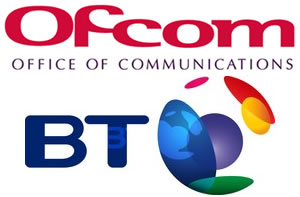 Ofcom are altering the very grandly named, “Universal Service Condition 1,” to let BT provide discounted connections to people on their Ebbsfleet Fibre optic trial, which plans to provide network connections of up to 100Mbps.
Ofcom are altering the very grandly named, “Universal Service Condition 1,” to let BT provide discounted connections to people on their Ebbsfleet Fibre optic trial, which plans to provide network connections of up to 100Mbps.
Search results for: “"Kingston Communication"”
Ofcom Gives BT OK For Ebbsfleet Fibre Trial Line Rental Discounts
Backgrounder on Local Loop Unbundling in the UK
With all of these moves towards digital delivery in entertainment, we thought it would be worthwhile understanding one of the key items in this process – how to get the digital content to UK households.
Steve Kennedy is an acknowledged expert in the telecoms and data networks field, so it was an obvious choice for us to ask him to write an overview of how other IP operators can compete with BT – by creating their own data network. To do this, they need to put their own equipment into the telephone exchanges that connect to peoples houses. That process is Local Loop Unbundling (LLU).
Over the next three days we’ll give you a full background in LLU in the UK.
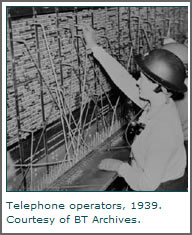 What is Local Loop Unbundling (LLU)?
What is Local Loop Unbundling (LLU)?
LLU is the ability to put equipment into BT exchanges (know as DLEs – Digital Local Exchange) and take over the copper line into the premises.There are two forms known as Option 2 (metallic path facility as BT call it) and Option 4 (shared metallic path facility).
Option 4 characteristics: –
- Operator takes over the line and only offers broadband services (of course they can offer services on top of the basic connectivity).
- BT retain control of voice services.
- BT send out the “Blue Bill”, this includes line rental and voice traffic which means they can still market their services to the customer.
Option 2 characteristics: –
- Operators takes over the line completely.
- No BT blue bill.
Once the operator has put the equipment into the DLE, then they have to connect it back to their own network. BT can provide this using BES (Backhaul Extension Services) or the operator can use their own connectivity solution. Most operators don’t have the coverage to provide their own connectivity solutions.
DLEs
BT have around 5,600 DLEs across the UK (i.e. telephone exchanges) and these have customers connected to them. Around 1,200 are in densely populated areas, another 800 or so with medium populations and the rest in rural areas. Any operator wanting to offer broadband (and possibly voice) has to put their equipment in these DLEs. However there is a cost to unbundling an exchange (around 100,000 including backhaul) which means operators are only targeting the most densely populated ones.
Any operator wanting to offer broadband (and possibly voice) has to put their equipment in these DLEs. However there is a cost to unbundling an exchange (around 100,000 including backhaul) which means operators are only targeting the most densely populated ones.LLU Operators
Operators who have unbundled exchanges are: –Any operator with a “-” after has been acquired by another player.
* AOL (UK) Ltd – CPW
* Be Unlimited – O2
* Bulldog Communications Ltd – Users to Pipex, LLU C&W
* Cable and Wireless Ltd
* Computacenter PLC
* Easynet – Sky
* Eaton Power Solutions
* eXstream Networks Ltd
* Groestar Ltd
* Kingston Communications (Hull) Plc
* Lancaster University
* Leanwood Communications Limited
* Lumison
* Nestor Electronics Ltd
* Opal Telecom (CPW)
* Pipemedia Ltd
* Pipex Internet Ltd – who knows, up for sale
* Tiscali
* T-Mobile
* UKBB
* Unisys Ltd
* Updata Infrastructure UK Ltd
* Videonetworks Ltd – Tiscali
* Wanadoo
* WB-Internet Ltd
* Zen Internet LimitedSome of the smaller players are conducting trials and some are just offering private services (like Updata who offer connectivity solutions to councils etc).
Tomorrow, the penetration of LLU in the UK and the economics of it.
Wales First For BT’s 21CN Next-Gen Network Rollout: Details Emerge
 BT has released detailed plans for the rollout of its next generation 21CN network.
BT has released detailed plans for the rollout of its next generation 21CN network.The technology will form the basis of BTs voice and data services for the near future, with the first area to be linked into the network being Cardiff.
And what finer city could they possibly start with?!
Between November 2006 and Summer 2007, 350,000 customers in the lovely, lovely Principality will be hooked up to the new network, with a rolling program scheduled to connect the rest of the country starting in 2008.
BT says that nationwide coverage should “substantially complete” by the end of the decade.
The 21CN network project sees BT shifting all voice and data services onto a single IP network that will carry fixed, mobile, voice, data, and video on-demand at speeds of up to 24 Mbps.
“Rebuilding the core telecommunications infrastructure of the UK is a massive undertaking,” said Deb Covey, managing director of BT Wholesale networks.
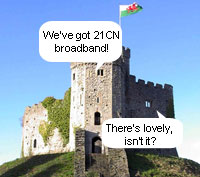 “Planning the rollout programme has been a complex task with industry consulted at every stage. Work is now well underway to create the new backbone for 21CN – this has to be in place across large parts of the UK before the first customer lines are switched across,” she added.
“Planning the rollout programme has been a complex task with industry consulted at every stage. Work is now well underway to create the new backbone for 21CN – this has to be in place across large parts of the UK before the first customer lines are switched across,” she added.Huw Saunders, of Kingston Communications, speaking as Industry co-chair of the Consult21 Steering Board, commented: “As an industry, we’ve participated in the development and design of BT’s programme to ensure that it takes into account the needs of everyone, regardless of which communications provider they choose to take services from.”
“What happens in Cardiff in a few short months is only the beginning of the journey,” he observed.
We only hope he wasn’t referring to Saturday night punch-ups on St Mary’s Street.
What is 21CN?
Here’s how BT describes the new technology:“21CN is BT’s next generation network which it is building in the UK and throughout the markets we serve. It is an advanced broadband network based on intelligent systems, Internet Protocol (IP), Session Initiation Protocol (SIP) and Multi-Protocol Label Switching (MPLS). IP is key to 21CN because it has the potential to act as a common transport protocol for all types of communication and applications; SIP allows the service provider to control the communications activity to meet a customer’s requirements and MPLS enables the efficient designation and routing of IP traffic flows.”
KiT, UK IPTV Pioneer To Close
 It is with great sadness that we hear that UK IPTV innovator KiT (Kingston interactive TV) is to close its doors on 3rd April. We’ve always been huge fans of their work.
It is with great sadness that we hear that UK IPTV innovator KiT (Kingston interactive TV) is to close its doors on 3rd April. We’ve always been huge fans of their work.KiT was delivering IPTV, before most people who are now getting excited about the potential of delivering content over a network cable, even understood what IP stood for. How long back? 1999.
Kingston Telecom (KT), who own KiT has always been a unique proposition in the UK which has always been dominated (some would say crushed), by BT. KT was the only independent telecoms company in the UK, originally owned by the local council, Kingston Upon Hull, until it was floated in 1999.
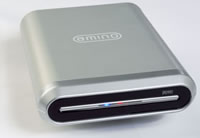 It’s always struggled to get sufficient subscribers to support the service. Hull is an area with much financial deprivation with the average family income around £14,000/year. It’s understood that the high point of subscriptions, 10,000 at the start of the service, has lead to the current low point of 4,000. The level of financial loses and the need for KiT to refresh its now 7 year old IPTV kit is understood to have lead to the decision. The parent company, Kingston Communications (KC), feel that they can no longer justify supporting the service
It’s always struggled to get sufficient subscribers to support the service. Hull is an area with much financial deprivation with the average family income around £14,000/year. It’s understood that the high point of subscriptions, 10,000 at the start of the service, has lead to the current low point of 4,000. The level of financial loses and the need for KiT to refresh its now 7 year old IPTV kit is understood to have lead to the decision. The parent company, Kingston Communications (KC), feel that they can no longer justify supporting the serviceMuch important work has been done at KiT with many benefits from the results.
One exceptionally inspirational example was the work they did helping to turn around a failing school, Kingswood School, by getting parents and therefore their children more involved with the education provided, through technology. We covered the story back in June 2004.
 Unknown to many, Blockbuster Video have been running a VoD trial on KiT for a couple of years. Their first in the world.
Unknown to many, Blockbuster Video have been running a VoD trial on KiT for a couple of years. Their first in the world.The BBC also benefited, after putting what we understand to be millions of pounds, into understanding how ultra local content works on IPTV over the KiT service.
About six months ago a very senior KiT person got in touch with us to say that they were up for sale.
One of the hopes had been that they would take their extensive IPTV experience, and roll it out over the UK.
 There has been some wondering around the Digital-Lifestyles office if the delay in closing KiT has been a considered position by the KC. By waiting until now to close KiT, the rest of the world now realise that they all need to be in IPTV, and the number of potential purchasers will have increased.
There has been some wondering around the Digital-Lifestyles office if the delay in closing KiT has been a considered position by the KC. By waiting until now to close KiT, the rest of the world now realise that they all need to be in IPTV, and the number of potential purchasers will have increased.Always one to identify a good buy, some are saying that Sky is interested in buying the remains of KiT. We understand from source inside KiT that this is unlikely, but in our view if they were to take on key members of staff, the purchaser would be getting their hands on very valuable experience. Skills like this would steer purchasers around many of the pot holes that IPTV can provide, potentially saving them millions of pounds.
We all hope that KiT, or at least its employees, have every success in the future.
London Schoolchildren to get Broadband Learning at Home
Soon, too soon for some, there will be no excuse for not having your homework done as London education authorities are planning to install broadband in the homes of London schoolchildren. , This initiative by the London Education authorities is timely in the light of a recent OECD report that identified “Disappointing” the use of ICT (computer & technology) in upper secondary schools, even in the most advanced countries, despite major investment outlays over the past 20 years.
With broadband already in more than 80 per cent of London classrooms, the plan now is to extend the initiative and allow pupils at primary and secondary schools, access to high-speed Internet services at home. That means a portal that supports a million people, who will have a personal log-on, 25MB of space, their own email and of course, access to a cornucopia of online learning materials.
As we’ve previously reported extending learning to the home has been very successful in trials in Kingston Upon Hull in the UK where, using the KIT TVIP service, pupils are able to work on the school’s servers using a keyboard, a Set Top Box and their television.
It looks like there will be very few excuses left for not attending class either, unless you are at death’s door, since the London Grid for Learning (LGfL) has created an education network that shares IT resources through classes held via video-conferencing, virtual field trips and personalised pupil programmes. Virtual field tripe, eh? Looks like you won’t even be able to say the damp brings on an asthma attack when the tree identification trip can be done from the comfort of that lovely classroom. The personalised learning feature will facilitate a managed learning environment, through online facilities.
When you put the words children and Internet together the result sparks fear in the hearts of many parents, so readers will be relieved to learn that the content filtering and managed access in place on the machines in schools is being extended to the children’s homes. In fact a service called ‘LGfL at Home’ will filter the home broadband service. Parents can have a password to circumvent the filtering while children can access the online learning resources.
Last April Digital Lifestyles looked at Kingston Communication’s collaboration with an East Yorkshire school that has led to an exciting project to engage pupils in interactive learning, both at home and in the classroom. (story link)Blockbuster’s Online DVD Rentals
Blockbuster Video have launched an online DVD rental business, much like that offered by Netflix. With a £13.99 (€20.78) subscription, customers can order up to three DVDs at a time from the online service. Blockbuster are are offering a library of 15,000 titles initially, with many more planned.
The service works in a similar fashion to those already in the market – you select titles from the website and up to three are sent to you from your list of desired films. When you’ve finished with a film, you return it in the reply paid envelope and the next film in your list is sent out to you. Subscribers never pay for postage no matter how many rentals they make in a month.
“Many of our customers rent on impulse and our stores are the perfect solution for this. However, the online service will suit those with very busy lifestyles who want a more up-to-date choice of movie than is available on the premium channels. It will be like having a multiplex in your front room.” said Steve Foulser, commercial vice-president of Blockbuster.
This is not Blockbuster’s first venture away from traditional forms for entertainment rental – the company is currently working with Kingston Communications to offer a video on demand rental service in Hull. Movies cost between £2 and £3.50 (€2.98 and €5.20) for a 24 hour rental, with television programmes costing £0.50 (€0.74) each.
Bringing the School into the Home via Broadband
As Britain moves closer to complete broadband coverage, communities around the country are beginning to explore the potential that interactive services offer and are partnering with technology companies and content providers to create some innovative services.
We decided to look at one of the best examples of community broadband TV: Kingston Communication’s collaboration with an East Yorkshire school which has led to an exciting project to engage pupils in interactive learning, both at home and in the classroom.
The Kingswood High School’s Broadband TV (KBTV) Project was conceived in 2001 under the UK Government’s Information Society Programme and Hull’s own Digital Learning Plan. Kingswood was chosen to collaborate with the BBC in its Headstart project.
The BBC provided the school with access to its film and video archive – and from this, using standard desktop tools like Premiere, pupils and teachers were able to create interactive content that formed the basis of many exciting and informative lessons.
Kingswood High went on to develop the idea into community broadband TV – with the aim of providing a range of interactive services via set top boxes (STBs). The school secured enough funding for the project to provide a one-year trial of STBs for all the families in the local community with a suitable phone line.
We spoke to Andrew Fawcett, Head of Products and Services at Kingston Communications about the stealthy growth of broadband television: “IPTV has come of age, and it’s come of age in a non-linear fashion. We’re on both sides of the equation, because part of our business is being a broadband ISP, and that’s been experiencing exponential growth, delivering one megabit of broadband to a consumer PC. Since 1998, we’ve been delivering five megabits into the back of people’s television sets with a service that people don’t know is broadband.”
We asked him for some background to the Kingswood project: “Everybody who goes to Kingswood School, all the kids basically as part of their school work, use the KIT service – it’s given to them free of charge. They’re creating their own content at school level.”
“The service covers 200 homes at the moment, but we have a proposal to roll it out to 2000.”
Staff at the school are finding that this new way of learning reaches and appeals to children who would not normally enjoy or benefit from traditional classroom teaching methods.
The interactive service provides immersive learning tools at school and at home. Andrew added, “They (the pupils) get the Kingswood Channel, a school’s TV channel with three elements to it. One is that we deliver curricular materials – there’s a permanently available set of resources for all subjects that’s very video rich.”
“The second part is taking stock materials and turning them into their own programmes.” Each (school) year has its own area on the service, though areas are accessible to everyone.”
As an example of this, Andrew showed us a documentary on arson that had been created at the school. The film had been constructed from content that was put together by the school’s pupils and teachers.
Part of the experience of learning about arson includes the kids going out with cameras and interviewing people. The idea of making children media literate is very powerful. I’ve seen kids who would be a nightmare in class, but this stops being class work, and becomes making a film – and more importantly it becomes a film that’s going to be on live telly when they get home. You can suddenly engage kids at a level that’s incredible. Very significantly, the school comes into the home.”
The film included an interview with victims of arson, and an arsonist – and was put together with standard desktop tools like Adobe Premier.
Interactive television like this also provides educators with valuable information on the effectiveness of services and lessons. “Year Ten”, he told us, “will be asked to go home and watch this as homework. We track usage for a select number of pupils who have chosen to opt in to the research elements in the programme. We’re looking at Educational Family Footprints. One of the key determinants of the success or failure in education is parental support. We’ve taken families with different educational footprints – from homes where education is core to the family life, to others where education is less important.”
The third aspect of the service provides pupils with a virtual PC they can access using their television set at home. The system runs a virtual PC using Citrix MetaFrame – all the processing is done at the server end of the network, which only sends screen updates to the set-top box. The box essentially becomes a “dumb terminal”. Pupils can access and save work stored on the school’s network, and use Star Office providing them with applications for word-processing, spreadsheets and presentations.”
A virtual PC service like this has many advantages, as the customers don’t have to maintain a PC at home and so security against spyware, hacking and viruses is taken care of by a qualified IT department at the school. It also ensures that pupils all have access to the same computing platform.
Andrew is justifiably proud of this aspect of the service, “Of all these things we’ve done with KIT, this brings everything together. It brings the localness and on-demand aspects of the service together, and it emphasises the difference of broadband TV – you could never provide an application like this with satellite TV. It’s wholly back-channel dependent.”
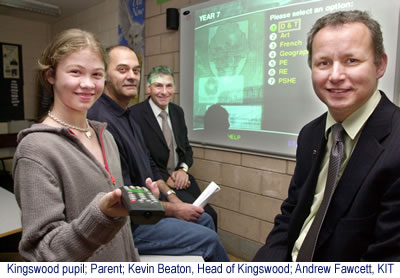 Kevin Beaton, Head Teacher at the school explains why they wanted to get so involved in a service like this: “The rationale for the whole project is that the school becomes the local hub that is able to provide the surrounding community with access to digital services. Initially the focus will be on education, so that we can prove to everyone involved that the principle of on-demand access to information and interactive educational content really is viable.”
Kevin Beaton, Head Teacher at the school explains why they wanted to get so involved in a service like this: “The rationale for the whole project is that the school becomes the local hub that is able to provide the surrounding community with access to digital services. Initially the focus will be on education, so that we can prove to everyone involved that the principle of on-demand access to information and interactive educational content really is viable.”Vein continued, “The school is currently developing material to be used on KBTV, and we’ve identified a number of logical and consistent uses for the system. Lessons in several departments are already being developed using our very latest interactive ‘White Boards’. This in turn means that teaching methods and the style of learning are changing, and more and more lessons will begin to make use of film and video as a stimulus to greater creativity. Some of the items will only be produced for homework purposes; hence students would be expected to watch educational material on film, and then complete set work on the film at home. Other material will be work from lessons at school, which can be completed at home, or perhaps reviewed at a later stage as part of a planned revision programme.
“Yet other material will be demonstration work from subjects like Design Technology, where soldering small intricate parts can be clearly be shown to pupils in close-up mode. In the field of Art it would be possible to view many different examples of paintings and sculptures, with the key points that ensured the success of the work clearly demonstrated.
“Another interesting aspect of the KBTV on-demand channel is that parents would have independent access to vital school information concerning their children. This would include attendance records, term dates, coursework deadlines, examination entries, parents’ evenings, exhibitions and school music and drama productions. In addition, direct contact could be made with school staff via e-mail, with the possibility of video conferencing for those parents or guardians who were unable to physically visit the school for whatever reason.”
And what about the future for services like Kingswood? Andrew Fawcett told us what was up next: “There was a very small budget for this – by squeezing things, as we tend to do, we managed to deliver it to 200 homes, to get a reasonable feel for the potential. This stage of the trial finishes in June – our intention is to look for additional sources of funding.”
Kingswood High and Kingston Communications are compiling information on the before and after effects of the KBTV initiative – hopefully benefits of this sort of programme will inspire more partnership and research in the educational possibilities of our broadband future.